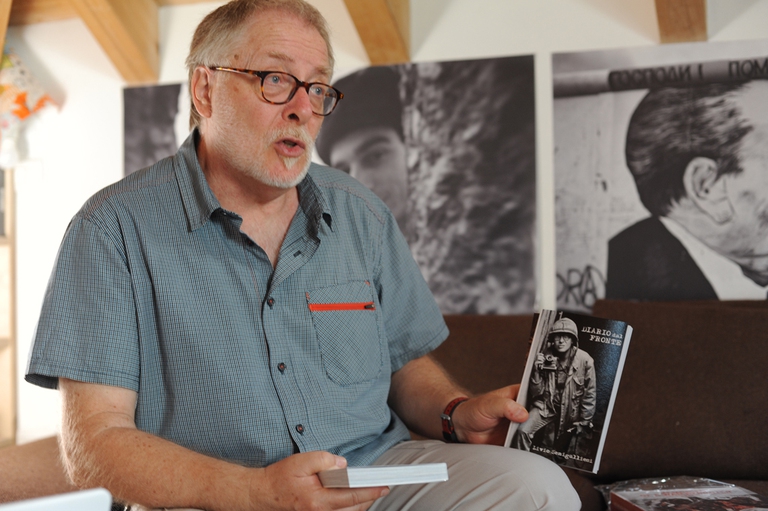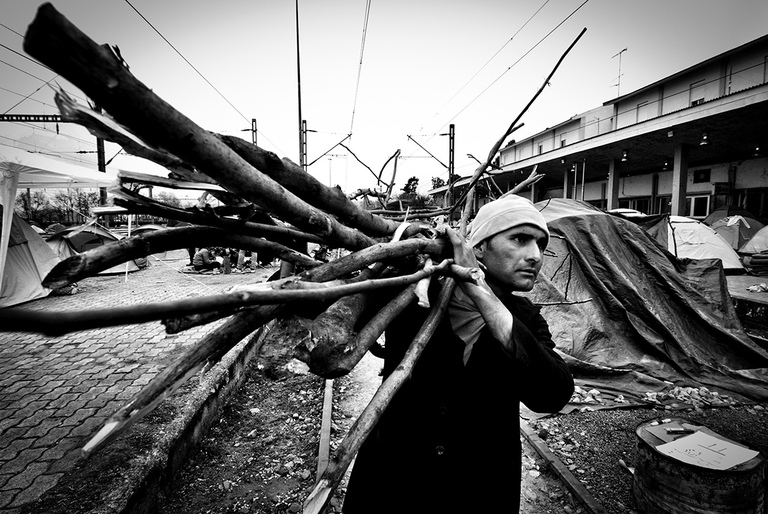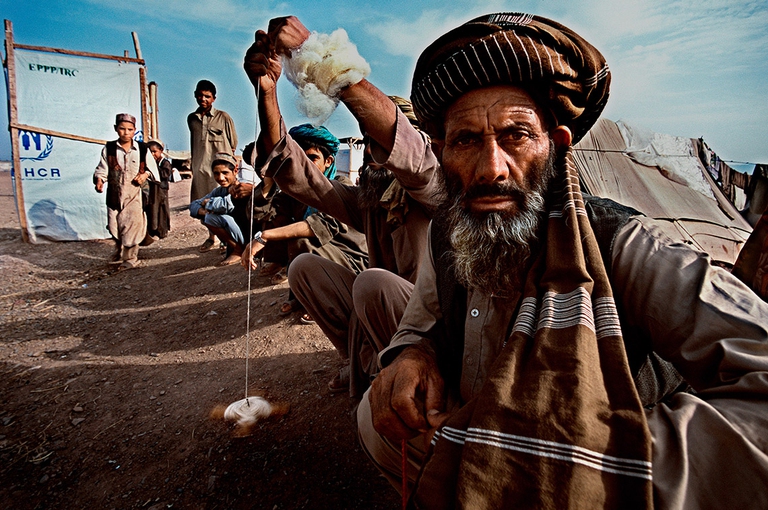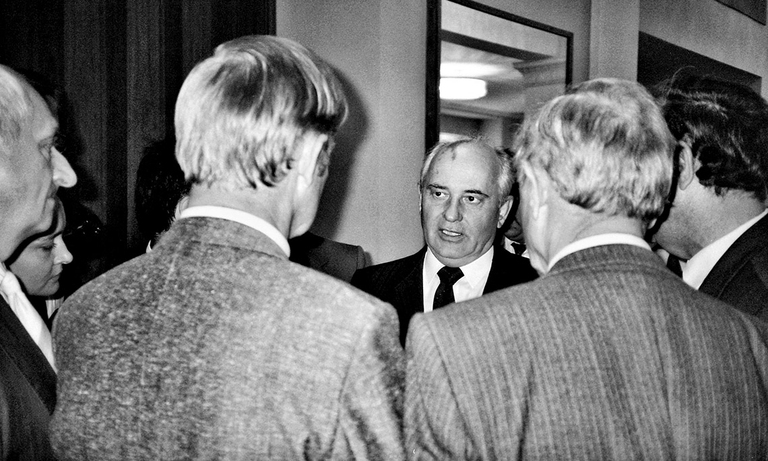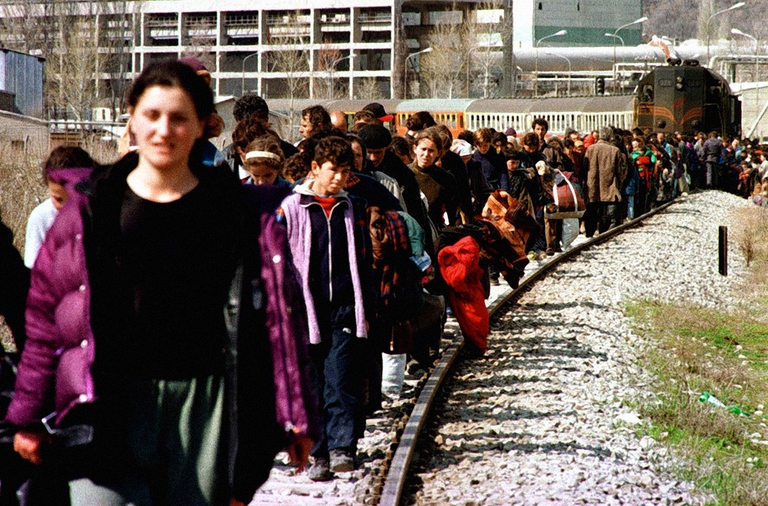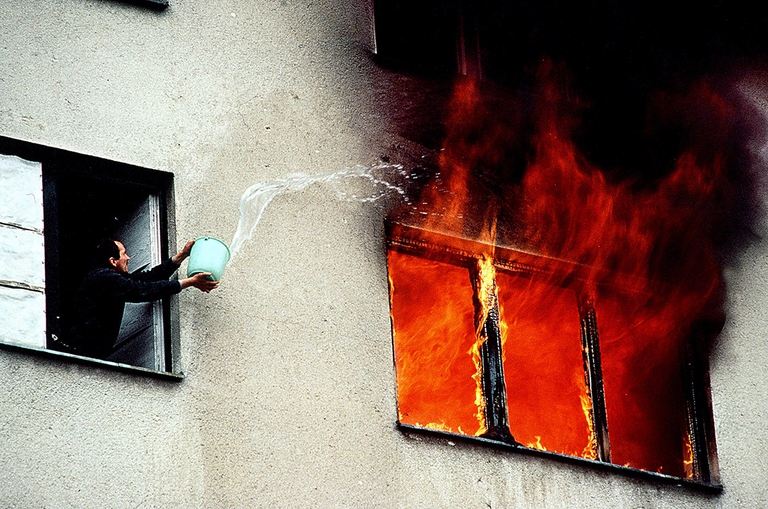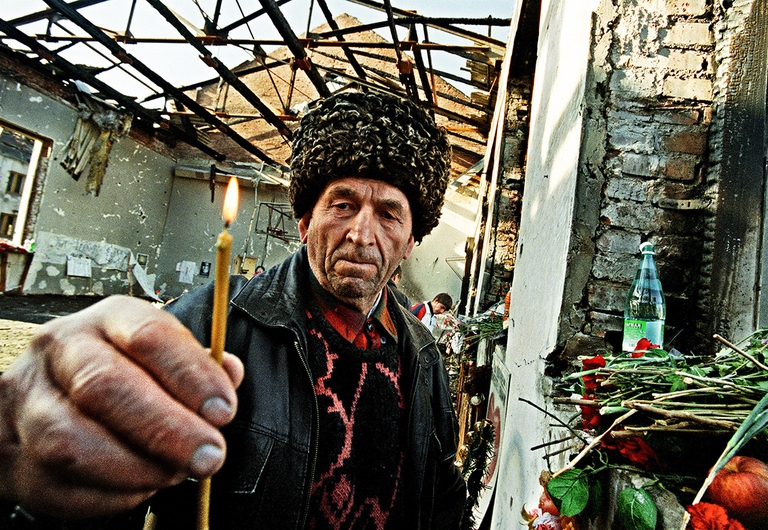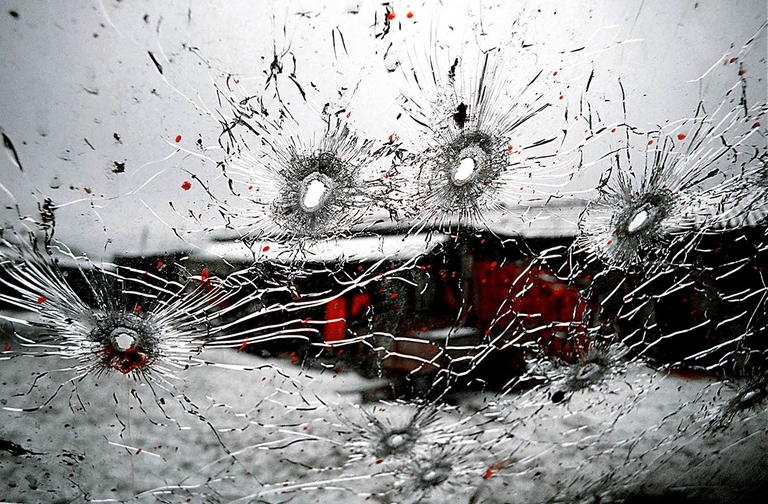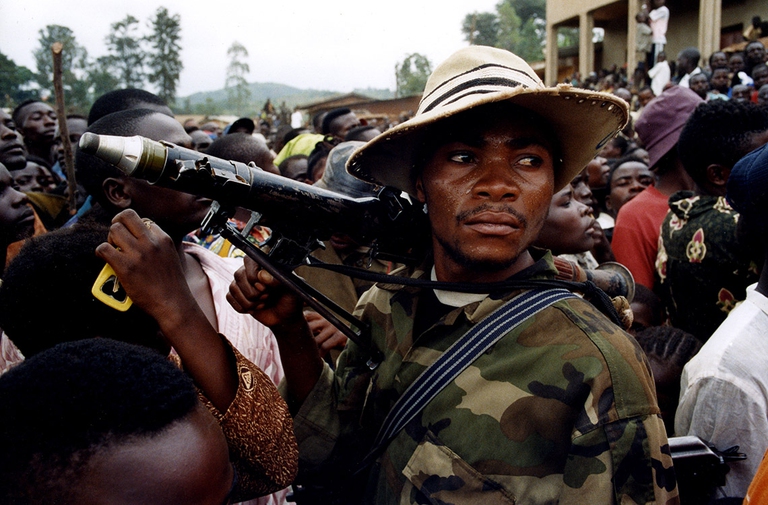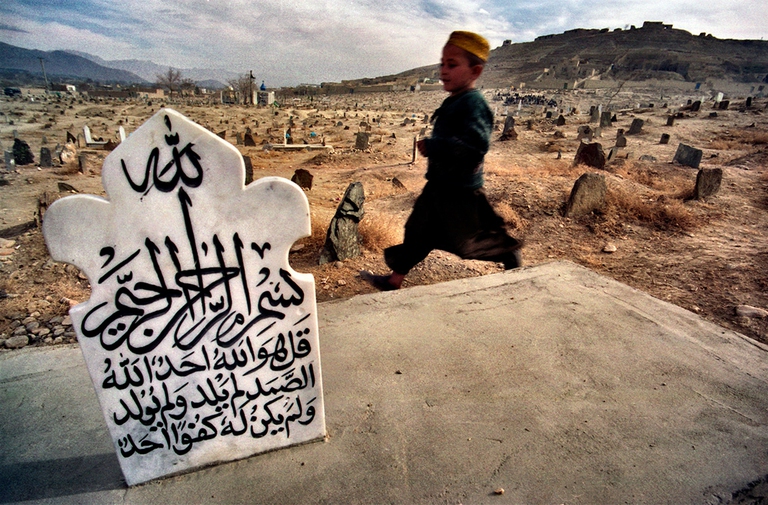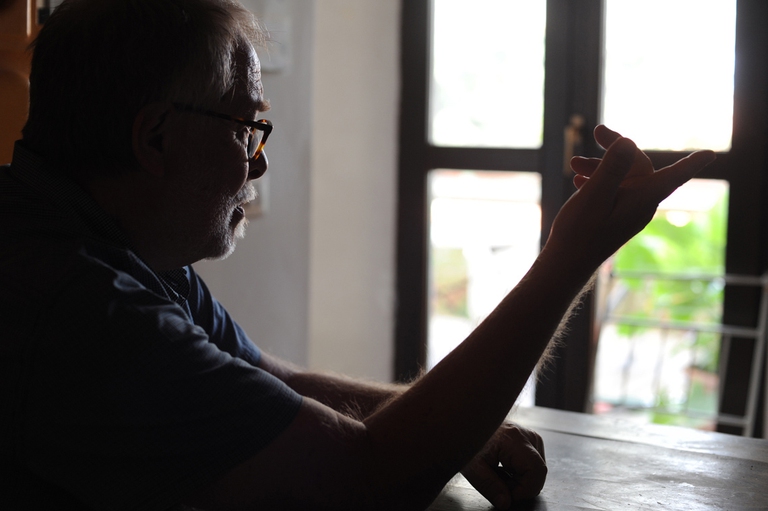
As per tradition after 12 years India held Mahakumbh, the world’s largest spiritual congregation that has been attracting pilgrims from across the globe.
Photojournalist Livio Senigalliesi tells his story, from the Yugoslav Wars to the Balkan Route. And through two videos, one created with journalist Raffaele Masto.
We’re met by the sound of a guitar solo, a foreshadowing of the energy embodied by the resident of this three-story Milan house. The following interview, in which Livio Senigalliesi tells us the story of his long career as a photojournalist, feels similar to that song. Just like The Stumble’s blues rock track All Over Again, it’s an immersive experience, full of surprises, shocking revelations, pain, stops and starts, humour, and a lot of soul.
Spread throughout the house, but tidily so, are Senigalliesi’s war correspondent boots, the photo ID from when he was on the frontline, a camera in a worn leather case. And, on the table, the book Memories of a War Reporter (Diario dal Fronte in the original Italian), which he presented on the 19th of September at photography festival ColornoPhotoLife in his native Italy. A few days earlier, on the 13th of September, an anthology of Senigalliesi’s work titled Effetti Collaterali (collateral damage) was inaugurated at the same festival.
“This book came out of my nightmares,” says Senigalliesi. His deep voice becomes light, vibrant. “But it was cathartic,” he adds, with renewed vigour. The author, 64, points out that he self-published the volume to avoid editorial constraints, and adds that the rights to the English version were purchased by the International Criminal Court (ICC) in The Hague.
What attracted the court’s attention were the facts and names Senigallesi reported relating to the Yugoslav Wars, which he followed from beginning to end for ten dangerous years. Self-taught and a history nut, Senigalliesi has had many close encounters with death, and has never been satisfied with the easy answer. Like Don McCullin, the British photojournalist who Senigalliesi greatly admires, he’s always pushed himself into the heart of darkness when reporting on world events. From the fall of the Soviet Union to the wars in Bosnia and Kosovo, from Afghanistan to Iraq via Lebanon and Africa’s Great Lakes. In Africa, he travelled with Raffaele Masto, a renowned Italian Africanist and radio correspondent who recently passed away.
Senigallesi discovered many uncomfortable truths. More than just fake news: lies, manipulations, simplifications and oxymorons – like “humanitarian war” – that have left their mark on contemporary history. In one of his most recent reportages, recounted in “Inside the Balkan Route”, Senigalliesi starts with a terrifying account. “In 2016, I travelled 1,000 kilometres from Greece to Gorizia, in Italy. In collaboration with NGO Médecins Sans Frontières, I began my journey near the Turkish coast and travelled to Idomeni, near the Greek-Macedonian border, and then further on, until we reached the Serbian-Hungarian border. I camped with refugees, recording their stories. Some survivors said they had suffered torture and had avoided organ trafficking. Many refugees had to put their lives in the hands of unprincipled people, who promised to help them in exchange for bribes. Instead, they took them to a ‘white house’ where they were beaten and fire branded with an ‘S’. Those who had no more money were sent on to the basement, where they were dismembered…”.
In Italy, your account was reported by Amnesty International spokesman Riccardo Noury on the Corriere Della Sera newspaper. Do you know if this Macedonian horror is still ongoing?
There’s no proof, but I assume so. And my sources in the Balkans tell me that torture is being inflicted in Croatia as well. They undress migrants in minus-twenty-degree temperatures and abandon them in the woods to die from hypothermia.
Who performs these tortures?
The traffickers. They’re criminals who went from pickpocketing on buses to the next level: the huge business that is migration. They don’t get their hands dirty with drugs or weapons. With just one migrant they can earn more, illegally, but without any risks. One minute later that person may be arrested by police or drown at sea, but they’ve already taken their money.
The media sometimes depict traffickers as individuals who “had no other choice”. Should this narrative be overturned?
Yes, the traffickers are non-persons. About 60,000 of them, an army of criminals from all the countries on the migration routes. The routes are many, and really long. My role as a journalist doesn’t allow me to express a moral judgement, I have to stick to facts. And, having met them, I know they’re all cutthroat mercenaries who have taken advantage of the situation. For Serbian war criminal Arkan, President Slobodan Milošević’s hero, the war in Yugoslavia was a great moneymaking opportunity. Traffickers who say they had no choice are lying, even the lower-ranking ones, the ones doing the grunt work. They rape and abuse anyone, women, men, children. In Libyan concentration camps, they beat prisoners’ hands with sticks when they hold onto cell bars. Those putting migrants on boats have these peoples’ lives in their hands. The softer narratives comfort us, but they aren’t reflected in reality. To really understand, you have to go into this hell.
You’ve been to hell many times.
I’ve seen a Holocaust whose consequences we’ll have to face sooner or later. I’ve seen migrants who never made it to their destination. The nameless dead. We don’t understand the scale of this crisis, what it means to die of thirst in the desert or drown in the sea. I know. I tried to save people and they slipped through my hands.
Aside from torture and trafficking in Macedonia and Croatia, you discovered another atrocity in Hungary. Can you tell us about it?
Still in 2016, disguised as a doctor, I was in an ambulance that was trying to reach refugees along the 70-kilometre “wall” built by Hungarian Prime Minister Viktor Orbán under the cover of darkness and with its lights off. We were able to reach this no man’s land from the Serbian border. There were about 70,000 migrants from Afganistan, Pakistan, Kurdistan and Syria, some camped in makeshift tents they had built themselves. The doctors tended to injuries and brought aid. It was illegal to be in that militarised zone, and the Hungarian police had the authority to shoot people on sight. And ten kilometres from there, in Nagyfa, it is said that there were concentration camps.
Concentration camps today, in the heart of Europe, without anyone doing anything about it?
Yes, the issue is shrouded in mystery. Those who were able to enter Hungary by paying traffickers risked being trapped there. One day, thanks to my Italian passport, I crossed the border once again. In a taxi, I followed a military truck that picked up women and children, i.e. the weakest people. The men were left there. Families were divided. But then, a soldier armed with an AK-47 stopped us, and the truck with the migrants disappeared into a forest of birch trees. The UNHCR (United Nations High Commissioner for Refugees) and Red Cross had no access to this secret zone. But it seems that not a soul made it out of this no man’s land.
Over the course of forty years of reporting, you made it to the heart of the truth. How did you do this?
It took rigour and many years of studying. If I hadn’t spent thirty years in war zones and hadn’t seen the places from which migrants are fleeing, I wouldn’t be able to understand their stories when they reach our coasts, or when I go and meet them at the borders of Bulgaria and Greece. If they come from Herat or Kandahar, in Afghanistan, we exchange a few words in Pashtu or Urdu. “So you know where we’re from,” they tell me. They trust me and speak more openly. In the West, they’re met with a wall of violence, misunderstanding and lack of solidarity. After so much despair, this is what hurts them the most.
You were born in a proletarian town, Sesto San Giovanni, to a mother who was part of the partisan resistance during World War II. Have you always felt this propensity for understanding others?
In the beginning, I was a real idealist, I had a great desire to change society. When I came back from military service, I went to work for a company in Cinisello Balsamo. I unloaded lorries from morning to evening.
Laughs
Then, I spent ten years making my bones as a journalist in Italy, covering social issues. This long period was necessary to give me a technical background and learn how to comprehend events. I took photographs and wrote for Il Manifesto (a communist newspaper, ed.), where I completed my apprenticeship. I documented labour protests and those against the Vietnam War.
What about your debut in foreign coverage?
It happened in 1986, to cover Mikhail Gorbačëv’s perestroika (a movement for political, economic and social reforms in the Soviet Union, ed.). I moved to East Berlin, a strategic place to document the changes that were taking place in Eastern Europe and the Soviet Union. From there, I went on my first exploratory travels to Moscow and Romania. Being part of a communist publication opened many doors for me in that region.
And, before everyone else, you were in Berlin when the wall fell in 1989. What is the trick to being the first person to break a story?
When you perceive change coming, go to the place where it’s happening. Be ready when things are happening. Living in the German Democratic Republic (GDR) for two years was indispensable to tell the story of the fall of the Berlin Wall.
In August 1991, only you and Newsweek photographer Peter Turnley were inside the Kremlin when Gorbačëv was being taken away. Did you immediately realise that it was a different kind of coup?
Ah, what a story… I was there because I was a communist, while Turnley was there because he was too influential. Astrit Dakli, who was Il Manifesto’s correspondent at the time, called me and told me to leave immediately because they might close the airports. Everything was about to go down. People in Moscow knew, but not those who lived outside the capital. Looking at Gorbačëv’s eyes as six brutes surrounded him, I had an inkling that this was an abnormal coup. The last act in an internal struggle between those who wanted perestroika reforms and those who, with the support of foreign powers, wanted the collapse of the Soviet Union. When I made my way out to the Red Square, I photographed Boris Yeltsin, an unknown man who could barely stand up because he was so drunk. He was waving the Russian flag, not the Soviet one, to incite people to support change – the end of the USSR – without a democratic process such as a parliamentary vote. Three days later Yeltsin forced Gorbačëv to sign, bringing about the end of communism.
In your book you talk about big lies. Among these, the idea that democracy happens quickly.
A fairytale told too many times. In Libya, for example, the killing of Muammar al-Gaddafi didn’t lead to democracy. The end of dictatorships almost always happens with violence and force. Often in a heartbeat, with foreign powers taking advantage of a moment of weakness and propping up a puppet regime. But creating real democracy takes time, occurring over the course of multiple generations. Yeltsin was manipulated by the United States, NATO and the CIA. The names of oil barons and oligarchs who had already left Russia to make a new life for themselves are well-known. Even the “5-day war” between Russia and Georgia in 2008 was orchestrated. Former President Mikheil Saakashvili is the son of a very powerful Georgian family based in the US. He grew up there and was sent by the CIA to train at their headquarters in Langley. Former Ukrainian PM Julija Tymošenko is another figure they pulled out of their top hat. These people were used by NATO to move their bases closer to Russia’s borders.
What, therefore, did the opening of Eastern Europe lead to?
By blocking Gorbačëv’s extraordinary reforms, the only thing that was created was a huge new market, with millions of new consumers. Capitalism asserted itself on easy prey. Those who brought about the change, aside from the creator of perestroika, didn’t care at all for these people’s freedom but were only interested in in what they consumed. I understood this as soon as the Berlin Wall had fallen. Thousands of Polish, Russian and Ukrainian people would arrive every day on trains from the East to go to Turkish markets and buy what they didn’t have. “I’m buying bananas for my grandchildren because they don’t know what they taste like,” one woman told me. The communist system took care of people from cradle to grave. The state guaranteed education, healthcare and employment. But everything that was allowed in the West was forbidden there. In 1986, Eastern Europe seemed stuck in 1945. Their clothes were from that time. Shops had two Baltic Sea herrings and four potatoes in stock, alongside rivers of vodka. It’s clear that they wanted more, they wanted blue jeans and wanted to listen to Bob Dylan. An example: today there’s no democracy in Romania, only the chance to emigrate to work as a maid or labourer, earning ten times as much as a Bucharest salary. And, so, World War II truly came to a close.
A journalist can’t talk about the present without understanding history. Was it thanks to your studies that you were able to untangle the ten-year-long conflict in Yugoslavia?
Yes. My passion for history came before that for photography. Yugoslavia was geographically close but almost incomprehensible. A halfway-land that had refused Stalin’s Soviet Union and was the leader of the non-aligned bloc. The war can be explained by what happened from 1980 onwards, after Tito’s death. He was able to keep six different but related republics together. For ten years, the media spread fierce propaganda, a blame-game for everything that had happened since the end of World War II. The killing, in May 1991, of a few Croat policemen at Borovo Selo was the spark that set off all the different conflicts. As if it was 1945 again.
The English version of your book was purchased by the International Criminal Court in the Hague. Were you expecting this?
When you get that close to fire… I always thought my duty was to document facts without expressing opinions. Never espousing a cause, but reporting all sides of a conflict. Serbians, Bosnians, Croats, war criminals, snipers, civilians. Wars are multifaceted, full of traitors, people who go from one side to the other, people who just want to make money. However, I wasn’t expecting to be approached by the ICC; it’s like a lifetime achievement award.
On page 57 of Memories of a War Reporter you write: “Srebrenica to the Serbs in exchange for Sarajevo to the Bosnians? No one will ever admit such a harsh reality, but in a war this dirty, everything is possible”. Why are some truths so uncomfortable that they’re never even revealed?
The forces that determine the course of war are many, and often distant from one other. The causes date back to a remote past, and there are huge things at stake. On the massacre of 8,000 Bosnian Muslims in Srebrenica, I can say they let it happen. It was convenient for everyone. The UN was tired of protecting the enclave. Furthermore, it was useful as a bargaining chip between Sarajevo, the future capital of Muslim Bosnia, and a region the Muslims would never have control of. A 70-kilometre sliver of land in the mountains, important because of its silver mines.
And, furthermore, there’s manipulation of information by the media…
Mass media are an entirely different battlefield. PR, marketing and propaganda companies are employed. Militarily strong Serbia won on the field, but it lost the communications war. Meanwhile, Croats, Bosnians and Kosovans used marketing strategies to persuade global public opinion that they were the victims. War, however, is more complex, and sometimes the victims become murderers. But this complexity isn’t understood by the wider public. It’s easier for media outlets to espouse one cause or another. Thus, the Serbians will always be the “baddies” in the eyes of history. Croats, for their part, looked for inspiration in a pro-Nazi past. Independent Croatia’s new flag bears the coat of arms of Ante Palevic’s government (1941-1945), which was allied with fascists and Nazis and ordered the deaths of 700,000 Serbs.
Were you the first journalist to discover the concentration camp at Jasenovac, a sort of Croatian Auschwitz?
Yes, in 1991. This camp was active between 1941 and 1943, but it had been erased from history with the help of then-bishop of Zagreb, Alojzije Viktor Stepinac. Pope Francis has put the brakes on his canonisation. The Serbs were on the offensive in Croatia to reconquer borderlands known as Krajina, which had been disputed since the time of the Ottoman and Hapsburg empires. I made it right to the frontline, with a bunch of press passes around my neck, by following Serbian paramilitaries from Arkan. I was next to the devil. And Serbian refugees would say to me: “You, an Italian, can’t understand. This is the end of World War II. You don’t know our history. You don’t know what Jasenovac is, you don’t know why we’re fighting”.
Another big lie you talk about is the “humanitarian war” in Kosovo. Can you tell us more?
There was a saying in Yugoslavia about the fight against the Ottoman Empire: “It all started in Kosovo, and it will all end in Kosovo”. This was in reference to the fact that Kosovo, as the cradle of the Orthodox Church, couldn’t be given away: it was like Jerusalem for Jews or the Vatican for Catholics. However, at the end of the 1990s, 70 per cent of the population was Albanian. The autonomy it had enjoyed was no longer enough, and the UÇK formed (Ushtria Çlirimtare e Kosovës, Kosovo Liberation Army). It was blacklisted by the US as a terrorist organisation. But, in August 1998, the situation was turned on its head. We were at the peak of the conflict between Milošević’s army and the Albanian UÇK paramilitaries. The wealthy Albanian diaspora in the US lobbied Washington to intervene against Milošević’s military. Seasoned US diplomat Richard Holbrooke travelled to Kosovo in secret and sat at the table with the current President of Kosovo, Hashim Thaçi, and other UÇK leaders.
These negotiations had some questionable points…
Holbrooke, the American fox, was in bed with former enemies. He accepted to help the UÇK achieve independence in exchange for a military base. Thaçi – who this year was indicted for war crimes and crimes against humanity at the ICC along with nine others – benefitted from intelligence, satellites, and strategic and tactical support. According to the agreement, weapons would reach the UÇK from Croatia. OSCE peacekeepers arrive to pave the way for NATO bombings, the so-called “humanitarian war”. In reality, they were all spies who looked like Robocop and didn’t raise a finger to help droves of refugees. The coalition, which included Italy, went to war without knowing why. They called it humanitarian and played the religious card, claiming their cause was just because they were defending Muslims. In truth, the fleeing civilians had never set foot in a mosque. After the attacks from the sky, NATO ground troops came in. 200,000 Serbs were forced to migrate northwards. NATO brought about a forced displacement, clearing out the Serbian minority and turning a blind eye to the destruction of 100 Orthodox monasteries.
In the African Great Lakes region, where you made a documentary together with late Raffaele Masto, everything is connected: different countries, conflicts, guerrillas, resource trafficking, corporate profits. But media narratives are fragmented. Is this an example of oversimplification?
Most certainly. The case of Rwanda is emblematic. After the genocide perpetrated by the Hutu against the Tutsi minority, the capital Kigali became a worldwide hub for the trade in diamonds, gold and coltan plundered from the jungle in neighbouring DRC. Tutsi President Paul Kagame’s regime, in power since the end of the massacres in 1994, is a fierce military dictatorship that supports militias in Kivu and Ituri. These regions are home to mines whose minerals are traded in Antwerp. Rich countries prop up the dictatorship because they need these resources. Coltan, a key material for mobile technology and hardware, is only found here and all these materials are worthless in the DRC because they aren’t edible, and people are starving. And the powers that be in the world of tech don’t care about the slaves that extract the minerals.
There’s no budding sustainable economy, like in the clothing and jewellery sectors.
Tech multinationals have no direct contact with these realities. The agents on the ground are Libyan traffickers with great expertise in this sector. They know how to arm and control the militias that monitor the mines by destabilising and conquering other areas.
The 19th anniversary of 9/11 took place this month. In your book, you break down the role of Islamic fundamentalists very clearly, going back to Bosnia…
Al Qaeda bases in Europe were in Bosnia; they had formed during the Yugoslav Wars. Militias came from Saudi Arabia, Qatar, Chechnya, the UAE, Afghanistan, Iran, Egypt, etc. The base at Bočinja was the best-known, and most dangerous one: a piece of Saudi Arabia on a hill 100 kilometres away from Sarajevo. After the Dayton Agreement (which ended the war in Bosnia in 1995, ed.) the mujaheddin were meant to leave. Instead, groups of local and foreign volunteers managed to obtain Bosnian citizenship by marrying local women and settled with their families in the homes of Serbian refugees. Approximately 160 families lived in the village of Bočinja. In July 2001, NATO even intervened to return the houses to the Serbs because some were resisting. After 9/11, it was feared that these groups, mixed in among Bosnian society, could potentially become terrorist cells.
At the time, the new war in Afghanistan was being talked about a lot more than this danger inside of Europe.
And yet, Bosnia is the “long arm” of Saudi Arabia, doing business with the West. And it would be in dire straits without its economic support. Occupying Afghanistan was strategic for the US and NATO to be close to China.
On page 80, you claim that there are some common features between Islamic fundamentalists in the Taliban and those in ISIS.
They both have the support of Saudi Arabia. ISIS is also supported by Qatar and Erdoğan’s government. What has their purpose been, at different times and across different theatres of war? The first answer is systematic destabilisation, reminiscent of the tactics used by the US in Salvador and Nicaragua in the 1980s. And then there’s former US President Bush Senior’s foreign policy. In 1991, he pushed hard for the first war in Iraq against Saddam Hussein. Destabilisation serves to impose military, economic and political control.
“Colour revolutions” and “Arab springs”. Do these labels hide different realities?
A new generation of journalists ran in to document them, celebrating with the protesters. This was a mistake. Journalists should never support one side or the other, and evidence is needed to really understand what’s happening and what the consequences will be. The first thing to do is to ask whether the demonstrators are being manipulated. For example, I know for a fact that, in 2014, individuals from Belgrade paid demonstrators in Kyiv 100 dollars a head. Furthermore, neo-Nazis infiltrated the protests. Journalists can’t drink up these lies just because they’re favourable to change. They should look at who came to power afterwards… Too many photographers come out of journalism school knowing how to use the technology, but less and less able to scope out the real news. They don’t have that sincere critical spirit that should drive every reporter.
Stories of war, often poorly told, dominate cultural festivals and exhibitions. Does this “mythology of blood” risk overshadowing other issues?
There are endless overlooked stories. Last year, the famine in the Horn of Africa affected millions of people but almost no one documented it. There was a time when reporters would have flocked there in droves. Meanwhile, small stories can be symbolic of bigger issues. By portraying a young person with no job security, you’re telling the story of a capitalist system that denies a future to new generations. So when I teach young people, who are often too arrogant, I explain that great stories can be found just behind the corner.
Have you ever felt disenchanted with photography?
I grew up using film and had to adapt to digital. Ethics, however, comes before aesthetics. When I use a digital camera, I still give myself the 36-photo limit I had with film. I follow the subject, look at it with my own eyes first, without filters. The means have changed, but my method hasn’t. Journalism won’t die: there will always be stories to tell, but we need more commitment to serious, precise and continuous information. The stimuli were different for me. I overexposed myself to pain, but I also learned a lot. The people I met hurt me, but they also nourished me with the intensity of their lives. Most of the time I did everything alone. I sent myself to Yugoslavia for ten years because I wanted to tell the story of the war until its end. The passion for history guided me, as did the desire to be where it was happening. After all, I grew up in Sesto San Giovanni listening to my mother’s stories of the resistance. I was so thrilled being inside the Kremlin during the so-called coup that I walked over to a phone and called her.
At the mere thought, Livio bursts out laughing. His laughter fills the room, and the music is ready to start again, deep and gritty as only blues can be.
Siamo anche su WhatsApp. Segui il canale ufficiale LifeGate per restare aggiornata, aggiornato sulle ultime notizie e sulle nostre attività.
![]()
Quest'opera è distribuita con Licenza Creative Commons Attribuzione - Non commerciale - Non opere derivate 4.0 Internazionale.
As per tradition after 12 years India held Mahakumbh, the world’s largest spiritual congregation that has been attracting pilgrims from across the globe.
Workers in tea gardens of West Bengal, India, that produces Ctc tea for domestic consumption complain that they have been devoid of basic facilities while political parties make hollow promises during every elections which are never fulfilled.
India is in the middle of the elections, but sadly none of the politicians have uttered a word on man-animal conflict that has been devouring several lives every year.
Manipur, a state in north-east India, is still reeling under the tremors of violence that broke out last year devouring lives and paralyzing the economy.
The government of Tanzania is currently planning to evict more than 80.000 indigenous Maasai people from their ancenstral land
A new UNU-INWEH report on the global bottled water industry reveals the massive scale of this market and the lack of strict quality controls.
Isatou Ceesay founded a social enterprise that is helping to fight plastic pollution and empowering women and young people to gain economic independence.
In 2020, Mihela Hladin made a radical decision that many, in recent times, have probably considered. This is her story, with photos by Matt Audiffret.
The Brazilian government has started evicting illegal gold miners, responsible for the health emergency that has hit the Yanomami people.
